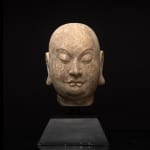Tang Stone Head of a Lohan or Disciple, 618 CE - 907 CE
Stone
30.5 x 17.8 cm
12 1/8 x 7 1/8 in
12 1/8 x 7 1/8 in
HK.2020
Further images
This is a stone sculpture of a Lohan or Disciple from Tang Dynasty. Peacefully gazing downwards, the figure has a serene yet reassuring facial expression, radiating a consolidating aura. He...
This is a stone sculpture of a Lohan or Disciple from Tang Dynasty. Peacefully gazing downwards, the figure has a serene yet reassuring facial expression, radiating a consolidating aura. He has round cheeks and a chubby neck, which are typical features of Tang art style.
Lohan (or Luohan) is the Chinese term used for an Arhat, these being the historical disciples of the Buddha. As with the passage of time Buddhist tradition developed, and especially in and among the East Asian Buddhist countries, the original number of Arhats or Luohans was characterised by a propensity to increase, and at least the most important of them were regarded almost as bodhisattvas or fully enlightened beings, with a wide range of supernatural powers. According to the standard Buddhist tradition, groups of 16, 18 or 500 luohans awaited the arrival of Maitreya, the Future Buddha, and such groups were very often re-created in various mediums in East Asian Buddhist art.
In Tang aesthetics, being chubby is an auspicious sign since it symbolises prosperity and material abundance. Applying this style to Buddhist sculptures reflect the belief that the figure is spiritually advanced.
Lohan (or Luohan) is the Chinese term used for an Arhat, these being the historical disciples of the Buddha. As with the passage of time Buddhist tradition developed, and especially in and among the East Asian Buddhist countries, the original number of Arhats or Luohans was characterised by a propensity to increase, and at least the most important of them were regarded almost as bodhisattvas or fully enlightened beings, with a wide range of supernatural powers. According to the standard Buddhist tradition, groups of 16, 18 or 500 luohans awaited the arrival of Maitreya, the Future Buddha, and such groups were very often re-created in various mediums in East Asian Buddhist art.
In Tang aesthetics, being chubby is an auspicious sign since it symbolises prosperity and material abundance. Applying this style to Buddhist sculptures reflect the belief that the figure is spiritually advanced.







